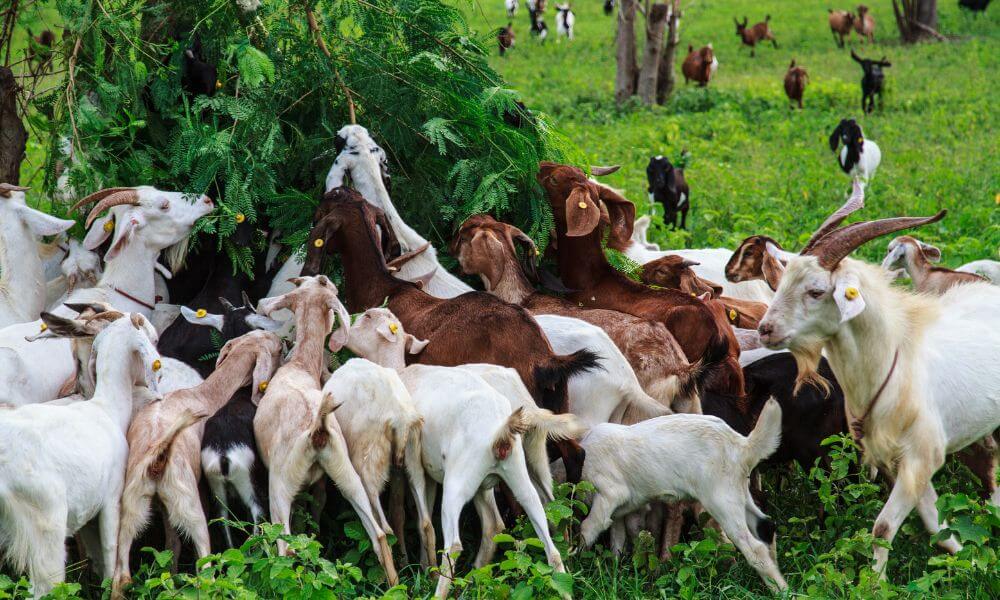Scientific classifications of animals are extremely numerous, and it is virtually impossible for anyone who is not a biologist specializing in these things to keep up with them all.
Every animal has a species, a genus, a class, a kingdom—the list goes on.
Goats are no exception, and you may have heard the term bovine being thrown around a lot when it comes to farm animals.
This confusion is not uncommon, largely because the use of the term bovine has somewhat escaped its precise meaning in popular use.
It has, in some ways, become interchangeable with livestock, and many think it refers to all farm animals.
Let’s look further into this.

Which animals are bovine?
Let’s start by looking at which animals fit into the bovine category.
Broadly, this family includes cattle, bison, African buffalo, water buffalo, and a couple of particular kinds of antelope.
So, this includes all kinds of domestic cows.
Currently, as far as our understanding goes, there is some debate about the precise evolutionary relationship between these animals.
They are, thus, classified into loose tribes, as opposed to the formal subgroups you would get in groups between which we are more confident of the relationship.
Broad characteristics include cloven hooves, true horns on at least one sex, and large size.
So, goats certainly do seem to fit these definitions.
Are they bovine, then?
Are goats bovine?
No, goats are not bovine.
They are caprine, which is an entirely different subfamily.
Goats do, however, belong to the family Bovidae—but don’t let this confuse you.
There are many animals in this family which are not bovine.
Whereas goats are classified in the subfamily Caprinae, cows and other bovines are classified by the subfamily Bovinae.
Bovidae includes the entire biological family of cloven-hooved, ruminant mammals.
Thus, goats are bovid, but they are not bovine.
If this sounds confusing, you are not alone.
As I said, animal classifications can be confusing to get to grips with if you are not a scientist who understands the nature of the relationship between these creatures.
As I said, there plainly are many similarities between goats and cows.
So, they do fit into the same broad categories.
But the relationship between cows and goats ends where the bovine begins.
Let’s look more closely at how goats and cows are related.
Are goats and cows related?
Yes, they are, as we’ve seen.
It’s just a question of how closely related they are.
Organisms are classified in the following ways: kingdom, phylum, class, order, family, and subfamily.
There are a lot of ways to distinguish and group animals together.
So, where goats and cows are related is in their family: Bovidae.
This is a broad biological family tree, including cows, bison, buffalo, antelope, and goats.
They are grouped by their classification as having cloven-hooves, and as being ruminants.
Being a ruminant means the animal chews its food, swallows it, then regurgitates it to chew it some more.
Both cows and goats do this, and thus they are related in this way.
Though we cannot say for certain when or where it lived, at some point in the distant past there would have been a creature that was a common evolutionary ancestor of goats and other Bovid creatures.
This is where their common traits originated.
What about goats and sheep?
Are goats and sheep related?
Goats and sheep are related, though, surprisingly to most, more distantly related than cows and goats.
Goats and sheep share what is called an infraorder, which is below suborder, which is in turn below the wider order.
This is the infraorder of Pecora.
This infraorder comprises all even-toed hoofed mammals with ruminant digestion.
Except for two extant genera, all members of the Pecora order have cranial projections from their frontal bones.
For goats and sheep, this is the horns of the males.
This is how sheep and goats are related, which is one step removed from the relationship between cows and goats.
Nonetheless, they are clearly related, and both are ruminants.
Again, like cows, sheep and goats have a common evolutionary ancestor—though it will have lived even further back than the common ancestor of goats and cows.
What animals are caprine?
So, what else fits in the same subcategory as goats? It is actually quite a limited subset of animals.
Capra, the genus, includes nine species.
The domestic goat is the most notable among these, but it also includes ibex, markhor, and mountain goats.
This genus excludes all else, though at times, some Ovids, like sheep, have been included.
As far as the most up to date science goes, caprine animals include ibex, tur, domestic goats, and markhors.
On the wider evolutionary stage, then, cows and goats are quite closely related.
They are even-toed, mammalian, four-legged, ungulates, reared for milk and meat and heavily changed by human selective breeding.
Nonetheless, goats are not in the bovine family, nor do they even share the same family as sheep.
They are outliers in that they are more closely related to deer and other wild animals than most farm animals tend to be.
